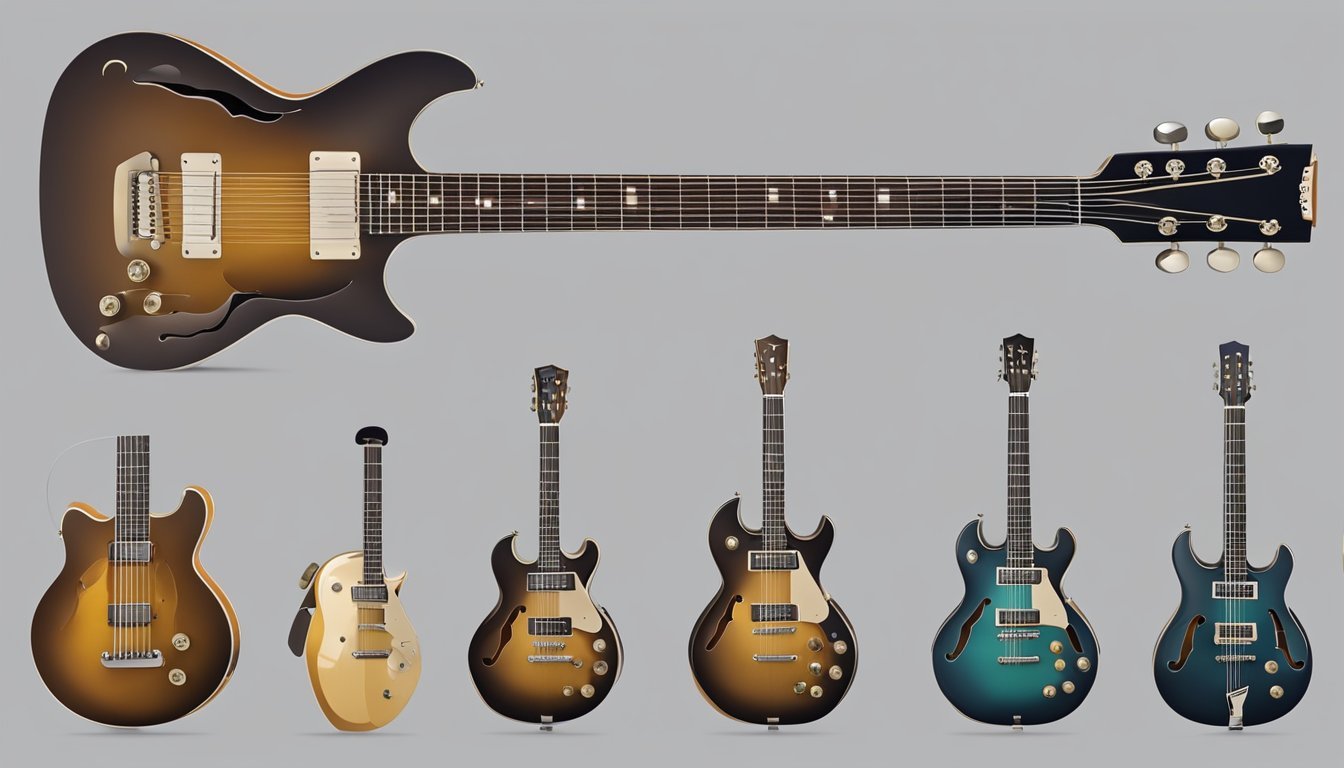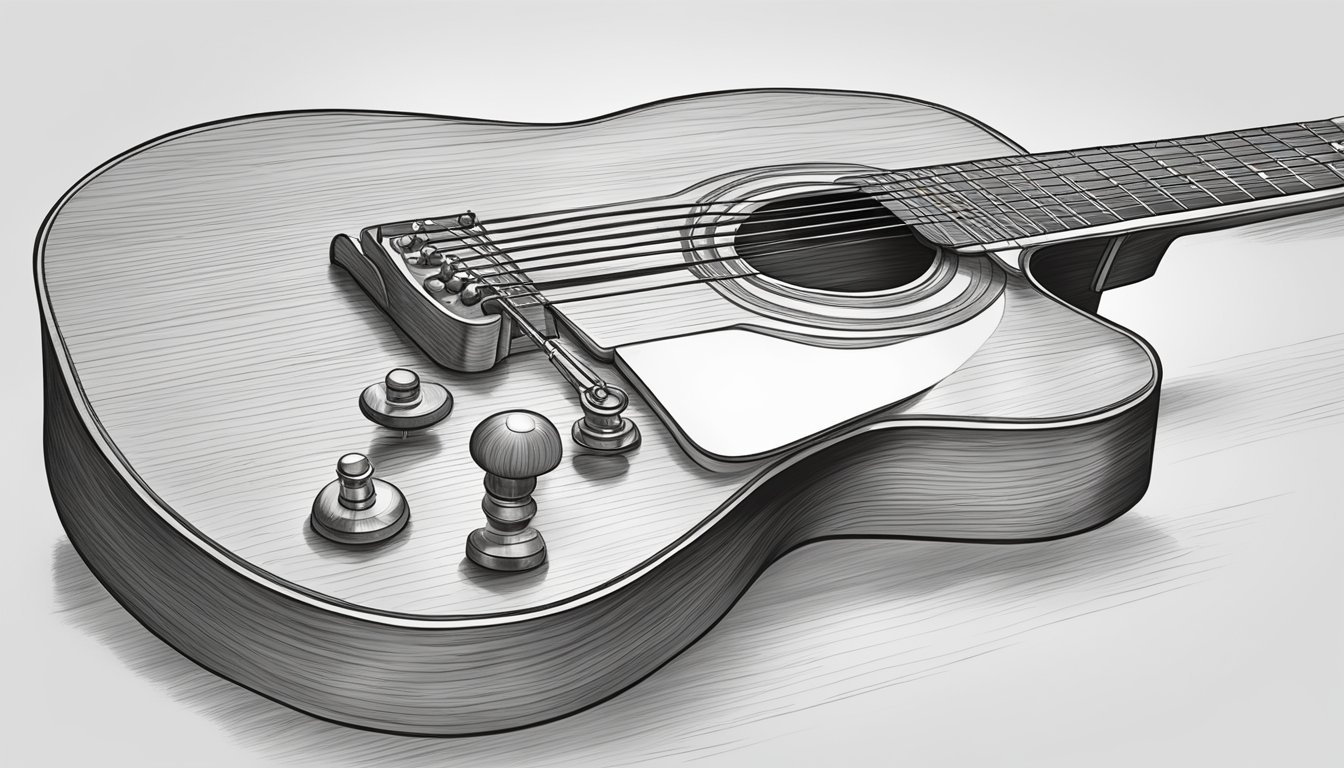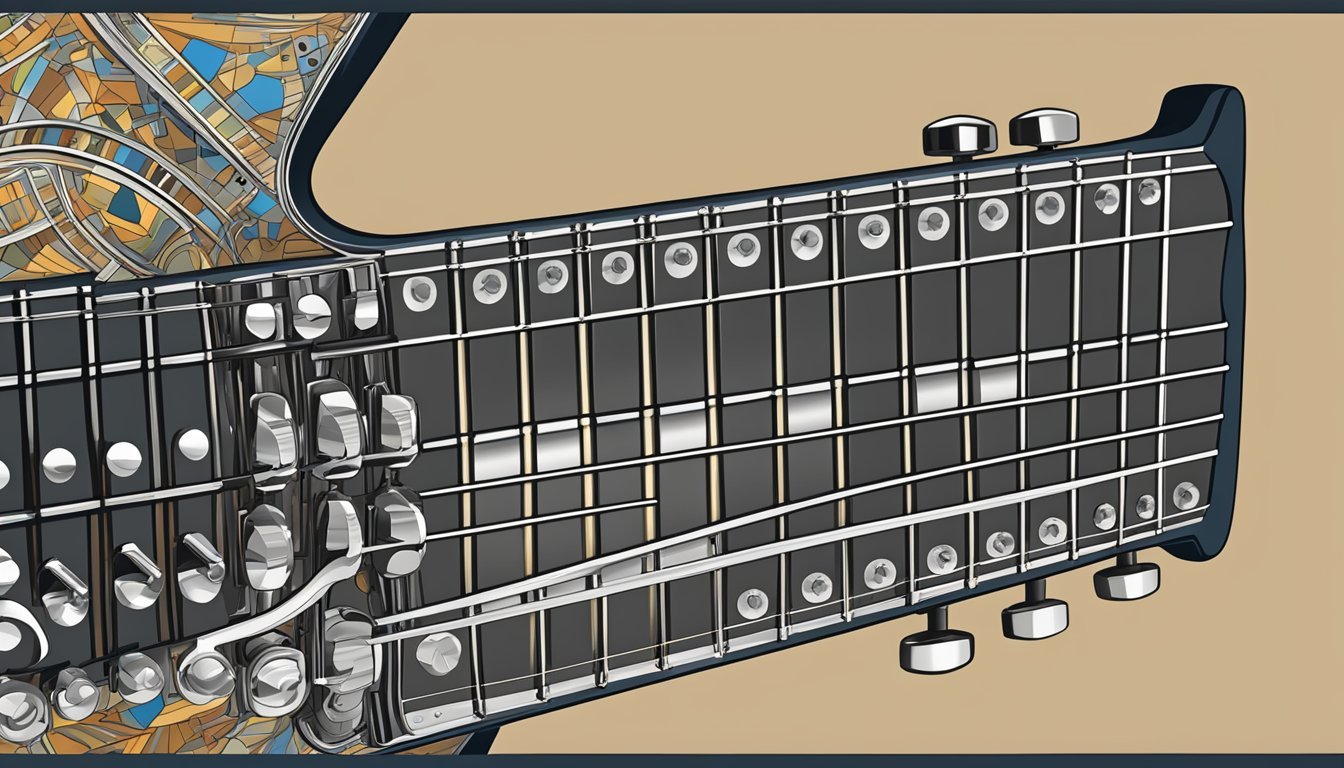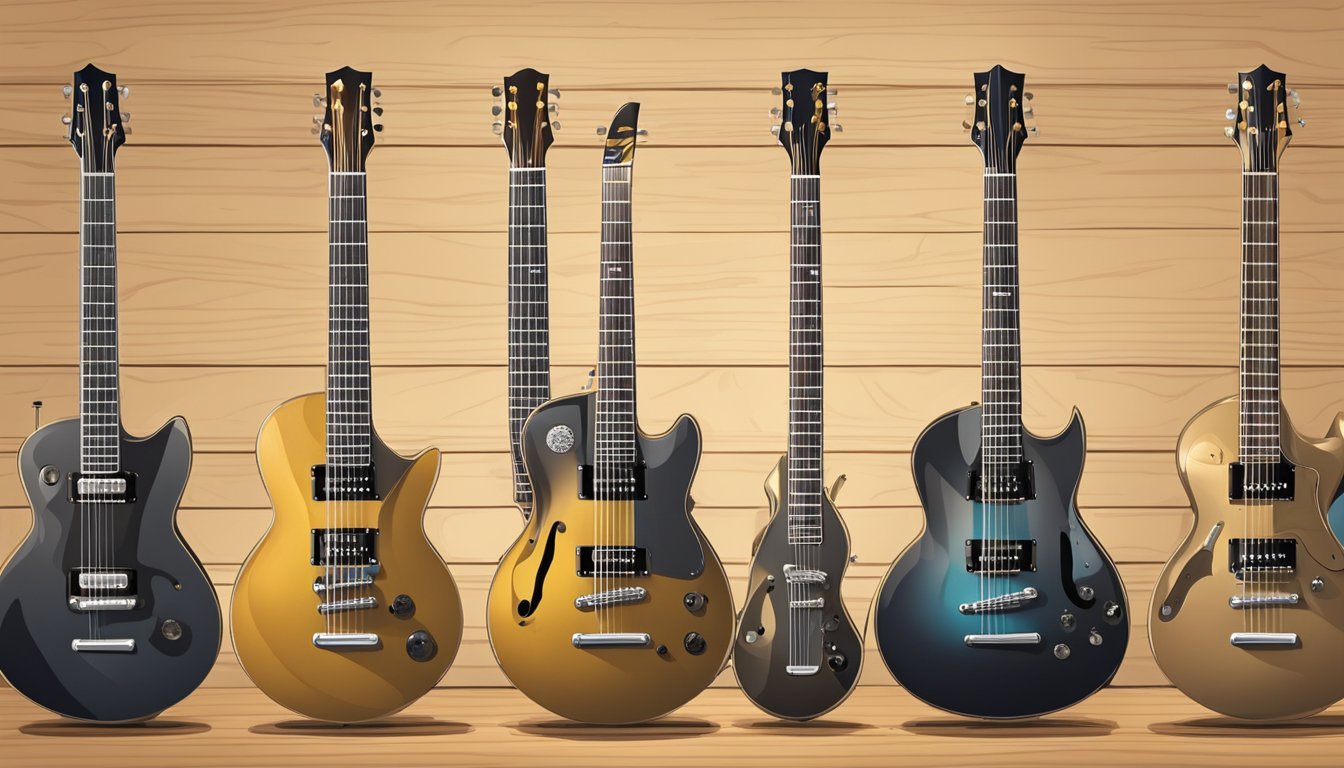When you pick up a guitar, one of the first things you notice is the six strings stretched across its body.
The names of these strings, from the thickest to the thinnest, are E, A, D, G, B, and E. Understanding these strings is key to playing chords and melodies effectively.

Each string has its role in creating sound, and how you tune them affects your music’s overall tone.
Knowing their order and names helps you navigate the fretboard with ease, making it simpler to learn songs and improve your skills.
By the end of this article, you’ll have a solid grasp of the strings on your guitar and their importance in your playing journey.
You’ll be ready to dive into techniques that will enhance your music-making experience.
Key Takeaways
- The guitar has six strings, which are E, A, D, G, B, and E.
- Tuning impacts the tone and sound of your guitar.
- Understanding string roles helps improve your guitar skills.
Guitar String Fundamentals

Guitar strings play a crucial role in your overall playing experience.
Understanding the different types and materials can help you choose what’s best for your style.
Exploring the Six Strings
On a standard guitar, there are six strings tuned to specific notes.
Here’s the order from the thickest to the thinnest:
- E (low E)
- A
- D
- G
- B
- E (high E)
This tuning helps create a range of pitches.
The low E provides a deep sound, while the high E adds brightness.
If you’re playing an acoustic or electric guitar, this standard tuning is common.
Each string is essential for different chords and melodies.
Material Differences: Steel vs. Nylon Strings
When it comes to guitar strings, the materials make a big difference in sound and playability.
Steel strings are typical for electric and many acoustic guitars. They produce a bright, crisp tone and can handle heavy strumming.
They’re also quite durable.
Nylon strings are primarily used for classical guitars.
They offer a softer sound, which is great for fingerstyle playing.
These strings are easier on the fingers, especially if you’re just starting.
Both types of strings serve different musical styles, so choosing the right one can enhance your playing experience.
Tuning and Tone

Getting your guitar tuned right is crucial for achieving the best sound.
The way you tune your guitar affects its tone and playability.
You’ll find standard tunings and some fun alternate tuning options can really change how your guitar sounds.
Plus, string gauge plays a big role in how your instrument feels and sounds when you play.
The Standard EADGBE Configuration
Most guitars are tuned to what’s called standard tuning, which is EADGBE from the thickest to the thinnest string.
Each letter represents a note that the string should sound when played open.
- E – 6th string (low E)
- A – 5th string
- D – 4th string
- G – 3rd string
- B – 2nd string
- E – 1st string (high E)
When you tune your guitar to this standard, you get a balanced tone that’s versatile for many styles, from strumming chords to intricate solos.
A reliable guitar tuner can help you get these notes exactly right, ensuring your sound is clear and harmonious.
Altering Sounds with Alternate Tunings
Sometimes, you might want to switch things up from standard tuning.
Alternate tunings like drop D tuning, where the 6th string is tuned down to D, can create a heavier, deeper sound.
Other popular tunings include:
- Open D: DADADE
- Drop C: CGCFAD
These tunings open a whole new world of sound and make certain chords easier to play.
They can change the voicing of your chords and give your music a unique character.
Experimenting with these options can lead to discovering new songs and melodies that fit your style.
The Impact of String Gauge on Playability and Tone
String gauge refers to the thickness of the guitar strings.
Lighter gauge strings are easier to play, bend, and fret.
They can also produce a bright, crisp tone.
On the other hand, heavier gauge strings offer a fuller sound and more volume but can be harder on your fingers.
Choosing the right gauge affects your tuning and tone as well.
For example, if you’re tuning down to drop D, thicker strings can maintain tension better, making your guitar sound richer and more resonant.
Anatomy of the Fretboard

The fretboard is an essential part of your guitar that helps you understand how to play notes and chords.
Knowing the names and order of the strings, along with how to navigate the fretboard, makes playing much easier.
Knowing Your Guitar String Names and Numbers
Your guitar has six strings, each with its own name and number.
From thickest to thinnest, they are:
- Low E (6th string)
- A (5th string)
- D (4th string)
- G (3rd string)
- B (2nd string)
- High E (1st string)
An easy way to remember this order is to use a mnemonic device: “Eagles And Dogs Get Bored Easily.” This helps you keep track of string names as you play.
The low E string is the thickest, while the high E string is the thinnest.
This distinction plays a big role in finger placement and string bending.
Navigating Open Strings and Frets
Open strings are the notes produced when you pluck a string without pressing it down.
The notes for open strings in standard tuning (EADGBE) are:
- Low E: E
- A: A
- D: D
- G: G
- B: B
- High E: E
As you move up the fretboard, each fret raises the pitch by a half step.
For example, pressing down on the first fret of the low E string gives you an F note.
When playing chords, you’ll often use open strings along with fretted notes to create fuller sounds.
Knowing the notes on the fretboard helps you find the right notes faster while playing.
Guitar String Variations and Accessories
When it comes to guitar strings, you have plenty of options that can affect sound and playability.
Understanding these variations and the accessories you might need can enhance your guitar experience.
Let’s break down what’s available.
A Spectrum of String Types
You can choose from different types of strings based on your guitar and playing style.
If you’re into electric guitars, nickel strings are a popular choice.
They offer bright tones and a smooth feel.
For acoustic guitarists, bronze strings are favored for their crisp sound and excellent projection.
They provide a rich tonal quality that complements various playing styles, from strumming to fingerpicking.
To ensure you find the perfect set for your instrument, consider the option to buy guitar strings locally, where you can often get expert advice and customize your selection based on your specific needs.
For a warmer sound, try brass strings or pure nickel strings, both of which provide richness in tone.
If you’re a fan of heavy gauge strings, they give a thicker sound, making them great for rhythm playing.
Acoustic and classical guitars use their own types, often with nylon strings for classical music or coated strings for acoustics, which last longer and resist dirt.
There’s also the unique option of DADGAD tuning, which suits certain fingerstyle playing.
The Role of Pickups and Guitar Type
Your guitar type influences the string selection significantly.
Electric guitars, like your Strat, depend on pickups to amplify sound.
Full-metal strings work best here, ensuring a strong magnetic field.
With pure steel strings, you get a bright, cutting sound that can really shine through your amp.
If your guitar has different pickups, it may respond better to specific string materials.
On the other hand, acoustic guitars resonate with their bodies, highlighting the importance of string choice.
Using the right strings can help you achieve a clear and balanced sound, making your playing more responsive and dynamic.
Must-Have String Accessories
Having the right tools can make string changing much easier.
A string winder is a must-have; it speeds up the process of tightening or loosening strings, saving you time.
For your daily routine, don’t forget to use a dedicated string cleaner or wipes to keep your strings in good shape.
This can increase their lifespan and maintain sound quality.
Consider also having string cutters on hand for a clean cut when changing strings.
With these accessories, you’ll spend less time maintaining your guitar and more time enjoying your music.
Frequently Asked Questions
Guitar strings can seem confusing at first, but they’re pretty straightforward once you get the hang of it.
Here are some common questions about string names, types, and maintenance that will help you as you learn more about playing the guitar.
What are the string names for standard tuning on a guitar?
In standard tuning, the strings on your guitar are named from the thickest to the thinnest as follows: E (6th string), A (5th string), D (4th string), G (3rd string), B (2nd string), and E (1st string).
Remember this order to tune your guitar properly.
How does string gauge affect a guitar’s playability and sound?
String gauge refers to the thickness of the strings.
Lighter gauge strings are easier to press down and bend, making them great for beginners.
Heavier gauge strings provide a fuller sound but may require more finger strength.
Can you list the order of strings from thickest to thinnest on a guitar?
Sure! The order of guitar strings from thickest to thinnest is: E (6th), A (5th), D (4th), G (3rd), B (2nd), and E (1st).
Knowing this order can help when restringing your guitar.
What’s the difference between acoustic and electric guitar strings?
Acoustic guitar strings are usually made of bronze or nylon, producing a warm tone suitable for folk and classical music.
Electric guitar strings, on the other hand, are typically made of nickel and steel, designed for brighter, sharper sounds often used in rock and pop.
How often should I replace the strings on my guitar?
You should replace your guitar strings when they sound dull or feel rough, usually every 1-4 weeks depending on how often you play.
Regularly changing your strings keeps your guitar sounding fresh.
What are some popular types of strings for beginner guitarists?
Beginners often choose 80/20 bronze strings for acoustic guitars.
These strings are popular because they produce a bright, crisp sound.
For electric guitars, many recommend nickel wound strings.
They are easier to play and sound great across various genres.

